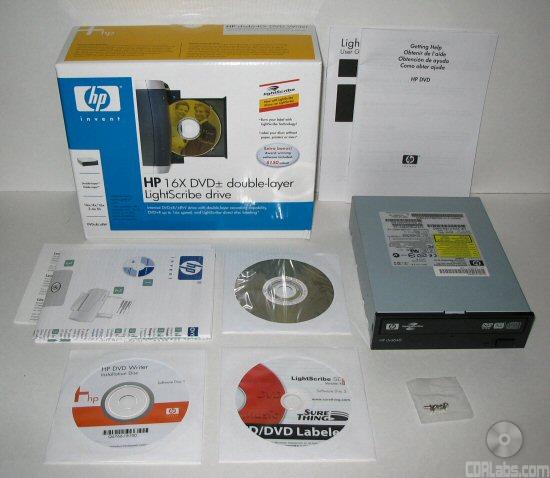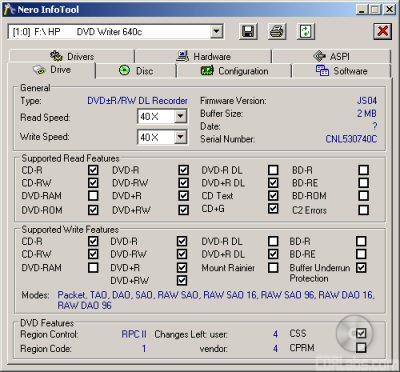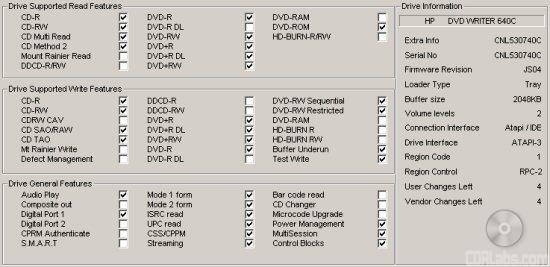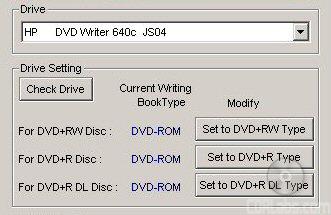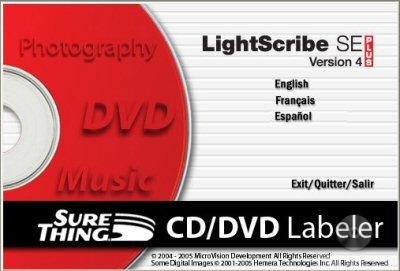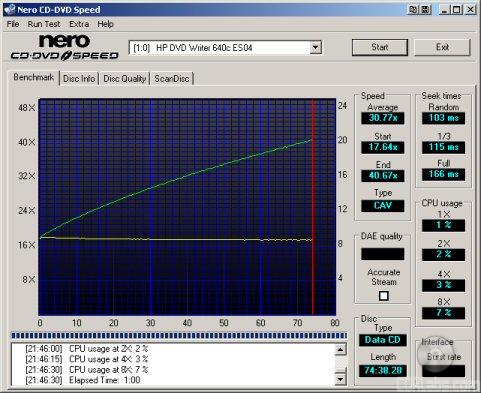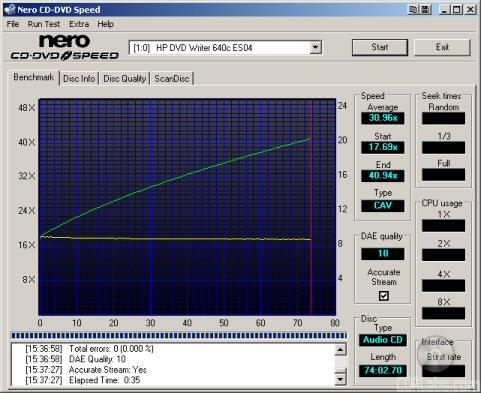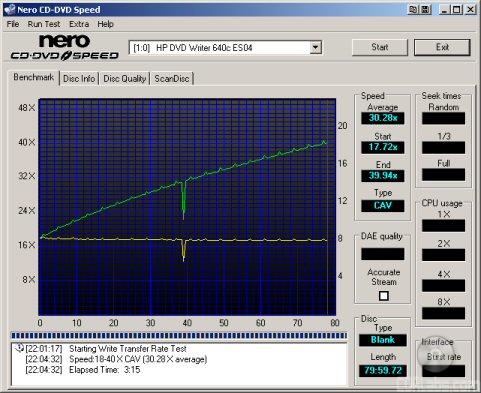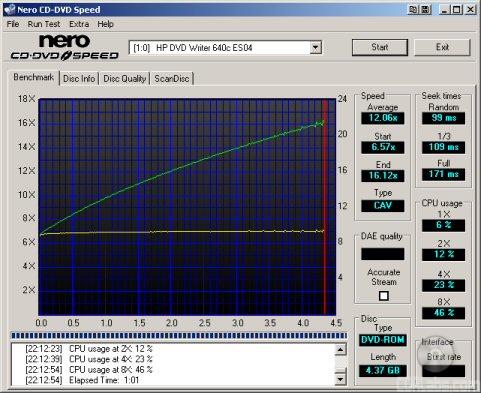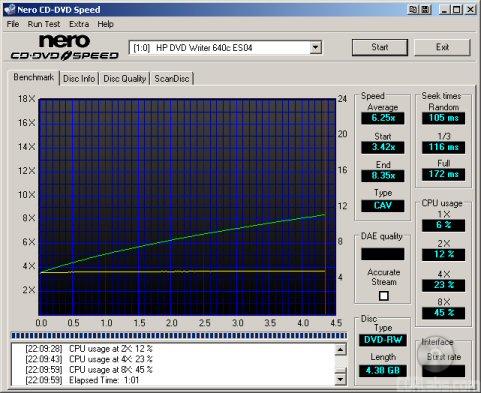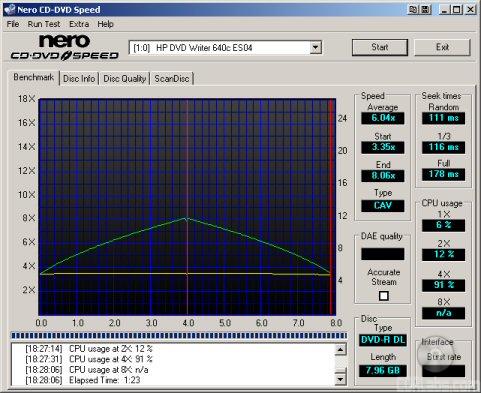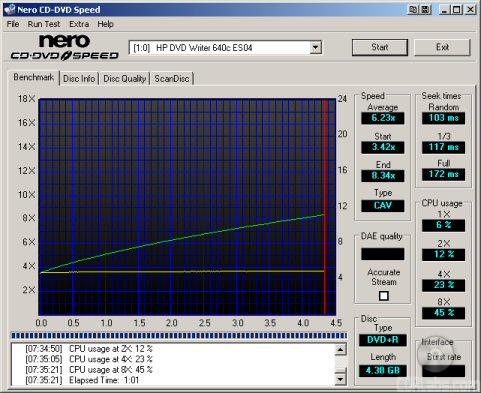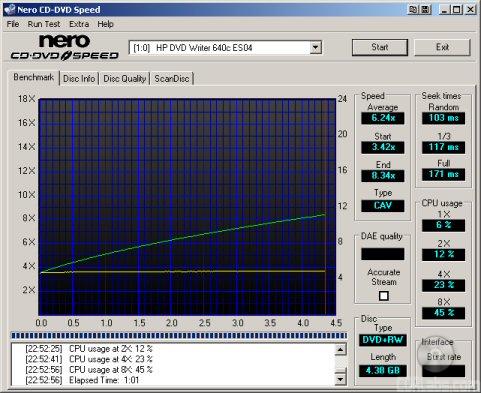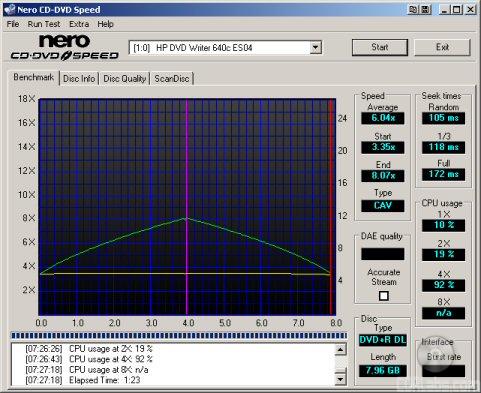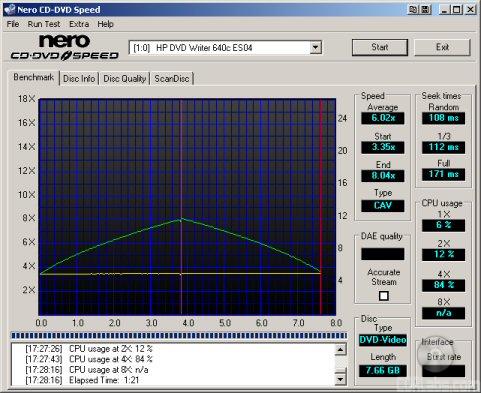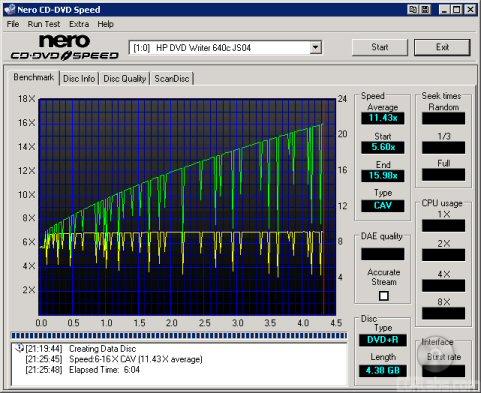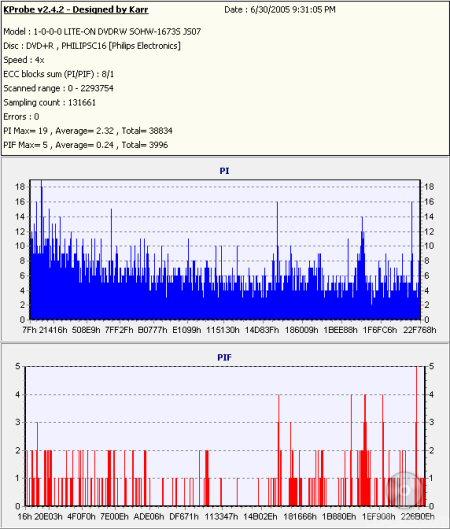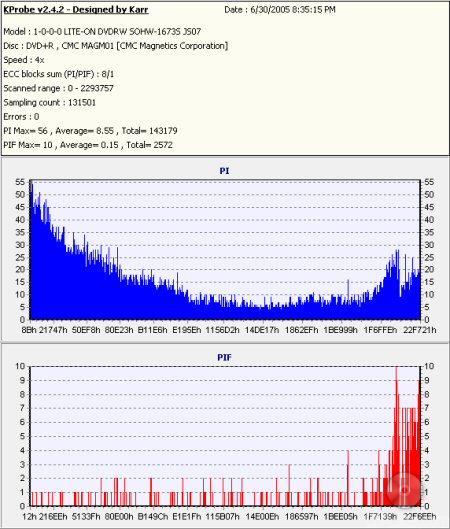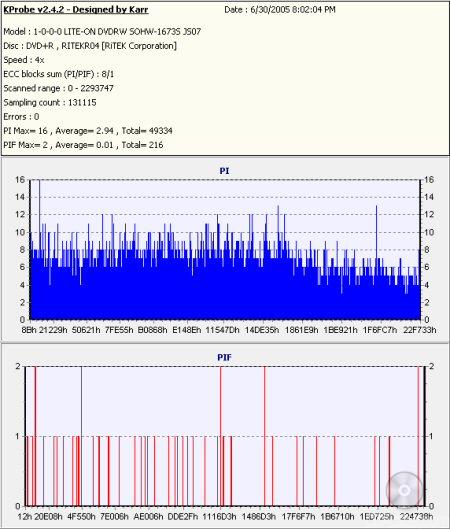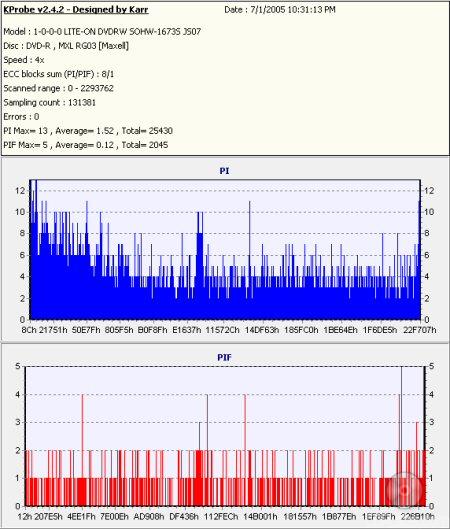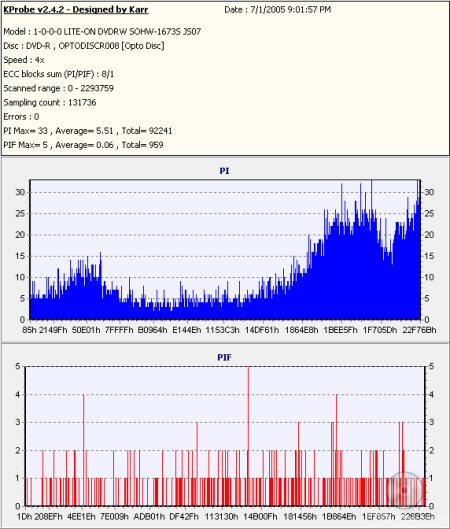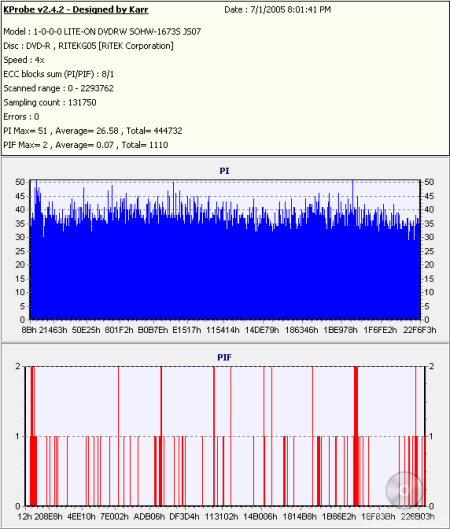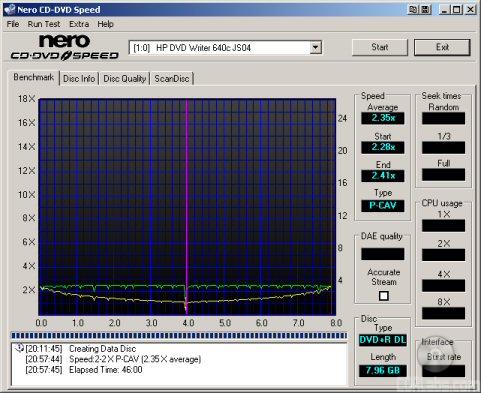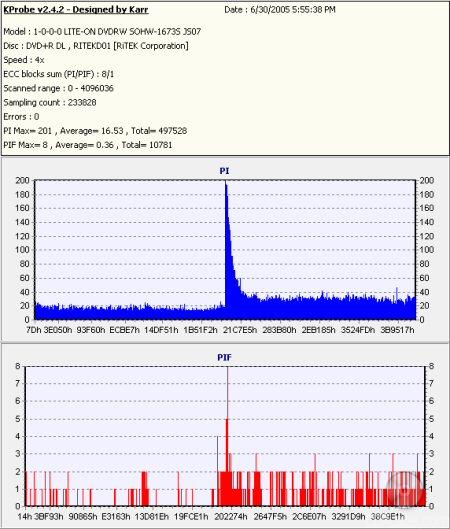Model: HP dvd640i LightScribe 16x DVD±RW
Manufacturer: Hewlett-Packard
As one of the biggest names in the computer industry, Hewlett-Packard doesn't need much of an introduction. Founded more than 60 years ago, HP got their start by producing electronic instruments. Over time, they expanded their product lineup to include computer products for both businesses and consumers. While best known for their PC's and printers, HP is no stranger to the optical storage industry. One of the founders of the DVD+RW Alliance, HP offers a wide range of products including their own line of DVD writers and blank media.

Earlier this year, HP introduced one of the first LightScribe enabled DVD writers. Based on the BenQ DW1625, the dvd640i is capable of 16x DVD+R, 8x DVD-R, 4x DVD±RW and 2.4x DVD+R DL writing speeds and a maximum DVD read speed of 16x. Along with support for LightScribe, the drive also includes features like 40x CD reading and writing speeds, 24x rewriting speeds, and a software bundle from companies like Sonic and SureThing.
We've had HP's new DVD±RW drive in the 'Labs for a few weeks now and have had the time to put it through its paces. To give you an idea of what to expect from the dvd640i, we'll take a closer look at its features and then see how it compares to some of the 16x DVD±RW drives from the competition. Is support for LightScribe enough to put HP's new drive on top? More importantly, is it the drive for you? We'll answer these questions and more in our review of the HP dvd640i.
What's in the box?:
- HP dvd640i 16x DVD±RW Drive
- Software CD
- SureThing CD/DVD Labeler CD
- Quick Start Guide
- Getting Help Guide
- LightScribe User Guide
- 1 Verbatim LightScribe 52x CD-R Disc
- Mounting Screws
Physical Features:
The drive HP sent us for this review was manufactured in January of 2005 and had firmware ES04.For this review the drive's firmware has been updated to version JS04.

There's no denying the dvd640i's origins. HP's new DVD writer is almost identical to the OEM version of the BenQ DW1625. The only real differences here are the "HP" and "dvd640i" logos. If you look closely you can see that the drive also has logos advertising support for DVD+R DL, DVD-R/RW and Ultra Speed CD-RW media as well as HP's LightScribe technology.
Like its BenQ counterpart, the dvd640i does not have a headphone jack or volume control. For most people, these little used features probably won't be missed. Looking at the front of the drive you can see that HP's new DVD writer has one LED. Depending on what the drive is doing this LED will light up green when reading and red when writing or erasing.
The rear of the dvd640i is fairly straight forward. By looking at the picture below you can see the drive's IDE interface, power connector and audio output connectors.
Starting from the left of the IDE connection you'll see the jumper switch for master, slave and cable select. By default the dvd640i's jumper comes set to master. Next to the jumper block is the analog audio connector. The connector on the far left is the digital audio output.
Technical Specs:
The specs below have been taken from HP's website and by running a few simple tests.
| HP dvd640i 16x DVD±RW | |
| CD Write Speeds | 40x (CAV) 32x, 24x (P-CAV) 16x, 12x, 8x (CLV) |
| CD Rewrite Speeds | 24x (P-CAV) 16x, 10x, 4x (CLV) |
| DVD+R Write Speeds | 16x (CAV) 8x (P-CAV) 4x, 2.4x (CLV) |
| DVD+RW Write Speeds | 4x, 2.4x (CLV) |
| DVD-R Write Speeds | 8x, (P-CAV) 4x, 2.4x (CLV) |
| DVD-RW Write Speeds | 4x, 2x, 1x (CLV) |
| DVD+R DL Write Speeds | 2.4x (CLV) |
| DVD Read Speeds | 16x Max (DVD-ROM Single Layer) 8x Max (DVD-ROM Dual Layer) 8x Max (DVD-R/RW) 8x Max (DVD+R/RW) 8x Max (DVD+R DL) |
| CD-ROM Read Speed | 40x Max |
| DAE Speed | 40x Max |
| Buffer Size | 2 MB |
| Random Access Times |
160 ms (CD) 160 ms (DVD) |
| CD Formats | CD-DA CD-ROM CD-ROM XA CD-R CD-RW CD-I Photo CD Video CD CD Extra CD-Text |
| DVD Formats | DVD-ROM DVD-Video DVD+R/RW DVD-R/RW DVD+R DL |
| CD Recording Modes | Track At Once Session At Once Disc At Once |
| DVD-R Recording Modes | Incremental Multi-Border |
| DVD-RW Recording Modes | Incremental Multi-Border Restricted Overwrite |
| DVD+R Recording Modes | Sequential Write Multi-Session |
| DVD+RW Recording Modes | Random Access Write Sequential Write |
LightScribe:
Note: We took a much closer look at LightScribe technology in our review of the BenQ DW1625. In this review we'll just go over some of the basics and see how the dvd640i performs with the bundled software.
The dvd640i is the one of the first drives to feature LightScribe technology. Developed by HP, LightScribe lets you burn durable, silk screen quality labels directly onto your CD's and DVD's using the same drive that burned the data. According to HP, it's as simple as burning the data, flipping the disc, and then burning the label.
Of course you can't do this with just any drive, media or software. While LightScribe capable drives use the same laser when burning both the data and label, they have to be able to accurately control the laser's focus and position as well as the spindle speed. They also must be able to recognize LightScribe media. These special discs have a thin dye coating on the label side that absorbs laser light. This triggers a chemical reaction that produces a color change, allowing the user to print text, artwork or graphics.
Even if you have a LightScribe capable drive and media, you will need software that supports it. Most major software companies have pledged support for the technology. However, at the time of this review, the list of compatible software is still relatively short. For the dvd640i, HP has turned to SureThing. Using the bundled software you can both create and burn LightScribe disc labels.
Once you've completed your LightScribe label, you're ready to print it. Before you can do this though, you will need to choose the quality. Keep in mind, this option not only changes the level of detail, it also affects the amount of time it takes to print the label. The better the quality, the longer the process will take.
How long does it take to print a label? For testing purposes, we created a few discs using Verbatim's new LightScribe CD-R and DVD+R media. In both cases, the quality was set to "best". The results are shown below.
While not part of the dvd640i's software bundle, I also printed a few LightScribe labels using Nero Express. Surprisingly enough, I found that the discs printed by the SureThing software did not look as good as those printed by Nero. Even after upgrading the LightScribe print engine, the black sections did not seem to be as dark nor was the text as sharp. Examples of this are shown below.
 |
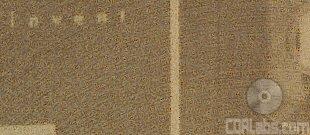 |
|
| SureThing CD/DVD Labeler | Nero Express |
Keep in mind, this seems to be an issue with the bundled software and notthe dvd640i. Like the BenQ DW1625, it produces great results with Nero's software. Hopefully HP or SureThing can fix this in a software update.
More Features:
By looking at the picture below, you can see that HP's new DVD writer is identified as an "HP DVD Writer 640c".
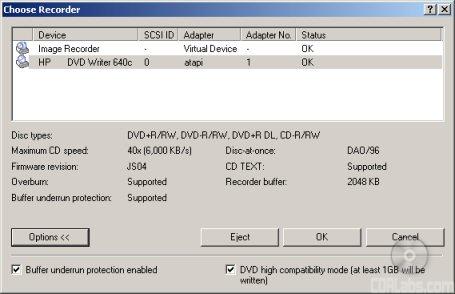
Nero also shows that the dvd640i has a maximum CD writing speed of 40x and a 2048KB buffer. This buffer is also backed up by some form of buffer underrun protection. According to Nero, HP's new DVD writer can also write CD-Text and overburn. When testing the drive's capacity, it had no problems overburning up to 99 minutes with our CompUSA media.
Like the BenQ DW1625, the dvd640i can do EFM encoding correctly. Using CloneCD version 4.2.0.2 with AWS disabled, Iwas able to reproduce older SafeDisc 2 protected titles like Max Payne along with some of the newer ones protected by SafeDisc 2.51 like Serious Sam: The Second Encounter.
Here is a screen shot from Nero's InfoTool. This program queries the drive to see what its reading and writing capabilities are. InfoTool had no problems detecting the dvd640i's maximum reading and writing speeds, recording modes, buffer underrun protection and 2MB buffer.
InfoTool also shows that the dvd640i is an RPC-2 DVD drive. This means that the drive's region is stored in the firmware. The drive's region can be changed five times and after that it cannot be changed anymore. A patched RPC-1 firmware can be downloaded here. Just keep in mind that it is not supported by HP nor by CDRLabs. Use it at your own risk.
While InfoTool gives us a quick glance at the dvd640i's features, DVDINFOpro provides a little more information on some of the drive's reading and writing capabilities. By looking at the screenshot above you can see that while BenQ's new drive can read and write to DVD+R DL media, it does not support the DVD-R DL format.
The dvd640i also supports a feature called "bitsetting." Using Nero, CD Speed or BenQ's QSuite utility you can set the book type for DVD+R, DVD+RW and DVD+R DL media. By doing so, your recorded discs will identify themselves as "DVD-ROM." This feature comes in handy if you have an older DVD player that has problems playing recordable media.
HP includes two CD's full of software with the dvd640i. These discs contain a number of applications including Sonic RecordNow 7.22, ArcSoft ShowBiz DVD 2, SureThing CD/DVD Labeler 4 SE and PowerDVD from CyberLink
Sonic RecordNow 7.22 -RecordNow is the main CD/DVD mastering program included with the dvd640i. With this software, users can create various types of CD's and DVD's or make backups of existing discs. RecordNow also has the ability to create "Jukebox CD's" full of MP3, WMA, or WAV files.
RecordNow's task-based interface is fairly straightforward. Simply select the project type and then the job you want to perform. If you can't figure out what project type to use, just drag the files you want to record onto the "bit budget" and RecordNow's intelligent drag and drop feature will select the project for you.
ArcSoft ShowBiz DVD 2 - With ArcSoft ShowBiz DVD 2 you can capture and edit your videos quickly and easily. Right from the start, ShowBiz gives you a number of options. From here you can record video directly to DVD, capture and edit videos or create your own VCD or DVD disc.
ShowBiz features a simple storyboard view for basic video sequencing and a more advanced timeline view giving you greater control over your movie clips, audio tracks and transitional effects. Once you're done you can export your video to a number of different formats or use ShowBiz's built in DVD authoring tools.
ArcSoft's software will also let you transfer video from your camcorder or TV tuner directly to DVD. Just choose the video quality and a menu style and ShowBiz will automatically capture the video and burn it to disc.
SureThing CD/DVD Labeler 4 SE - With SureThing's CD/DVD Labeler software, you'll be producing great looking labels in no time. This easy to use label design software includes an impressive number of templates, backgrounds and text effects. Adding playlists is also a simple task, thanks to its ability to pull artist, track and album information directly from your CD's and MP3 files or via the internet.
SureThing's CD/DVD Labeler software also supports HP's LightScribe technology. When you're done creating your label design, you can print it directly to disc. If you find that your LightScribe media is not supported, a newer version of SureThing's host software can be downloaded here.
CyberLink PowerDVD 4.0 XP - CyberLink's PowerDVD is one of the more popular software DVD players on the market right now. PowerDVD offers a complete set of navigation commands, including advanced features like multi-angle viewing, multi-language and subtitle selection, digital zoom and even parental control.
Unfortunately, the version of PowerDVD bundled with the dvd640i only supports 2 speaker output. If you want to take advantage of DVD's encoded with DTS or use Dolby Pro Logic II, you'll need to buy an upgrade first.
It should be pretty clear that HP's new DVD writer isn't lacking in the features department. Like the BenQ drive its based on, the dvd640i supports most CD and DVD formats has specs like 16x DVD+R, 8x DVD-R, 4x DVD±RW and 2.4x DVD+R DL writing speeds and a maximum DVD read speed of 16x. Along with support for LightScribe, the drive also incorporates a number of useful features like buffer underrun protection and bitsetting. Last but not least, HP tops all of this off with an odd, but interesting mix of software from Sonic, ArcSoft, SureThing and CyberLink. With all things considered, the dvd640i gets a solid 9 out of 10 for its features.
Installing HP's new DVD±RW drive in our test computer took only a couple of minutes. After taking the dvd640i out of the box, I left the jumper set to master and installed it on the secondary IDE chain by connecting the IDE cable and power connector. When I turned on the computer the BIOS detected it as a drive supporting UDMA 33. After making sure that the DMA was enabled in the Device Manager, I was ready to start installing the software.
Software Installation:
As I mentioned earlier, the dvd640i comes with two CD's full of software. The first of these contains a few different applications from Sonic, ArcSoft and CyberLink. If you have autorun enabled on your computer, the menu pictured below will automatically come up when you insert the disc.
From here you can either watch the installation videos or install the bundled software. If you're new to upgrading or working on your computer, I recommend checking out the videos, as they are pretty good. HP even has different videos depending on if you're upgrading an existing drive or installing an additional one.
Installing the software is pretty straightforward. Once you pick what programs you want to install, the files are copied over. When that is done, HP's Install Assistant will start. The HP Install Assistant checks your computer's configuration. If an HP drive is not detected, it will tell you what the best settings are for your computer. When it's done with that it will prompt you to print out the instructions and then help you shut down the computer.
The second disc contains SureThing CD/DVD Labeler 4 SE. Like the other software, the installation process is fairly straightforward. If autorun is enabled, the installation program will start up when you insert the CD. All you need to do is choose what language you want and pick your installation options. Once the files are copied over, you'll be able to create your own labels.
Documentation:
Since it's been a number of years since we've taken a look at one of HP's drives, I really did not know what to expect from their documentation. Surprisingly enough, things haven't changed very much. Like HP's previous drives, the dvd640i came with a few small guides, but nothing that looked like a manual. The manual is actually located on the software CD in HTML format and is copied to your hard drive during the software installation process.
HP has taken an interesting approach with their manual. Instead of focusing on the dvd640i, they provide instructions on how to do various tasks with the bundled software. The manual tackles everything from copying discs to editing video. While they could probably use a few more pictures, the instructions are quite good. HP also provides a list of frequently asked questions as well as a list of specifications for the dvd640i.
The dvd640i also comes with not one, but three printed guides. The first of these is the "Quick Start Guide." This fold-out poster walks the user through the installation process. The pictures are large and the explanations are clear and easy to understand. HP also includes a "LightScribe User Guide". Like the name implies, it focuses mainly on the LightScribe technology. Last but not least, there is the "Getting Help Guide". This guide helps the user collect information about the drive and then gives them the phone numbers and email addresses where tech support may be reached.
Looking at the dvd640i, it's easy to see why HP's drives are a big hit with consumers. While different than what we're used to seeing, the documentation and software make the installation process a no-brainer. At the same time though, I'd like to see a little more information about the drive itself. Even then, the dvd640i scores a 9 out of 10 for the installation portion of this review.
While CPU, memory, OS and other variables don't often make a huge difference, there are some nonetheless. We have a computer that is used only for testing hardware. We do this so all tests can be compared reliably.
Test System:
| CPU: | AMD Athlon 64 3200+ 2.0GHz | |
| Motherboard: | ASUS K8V SE Deluxe with BIOS 1003 | |
| Memory: | 2 x 256MB Kingston PC3200 | |
| Video Card: | XFX NVIDIA GeForce FX5200 - ForceWare v56.72 | |
| Hard Drive: | Hitachi Deskstar 7K80 80GB SATA 7200RPM | |
| Operating System: | Windows XP SP1 - VIA Hyperion 4in1 v4.51 |
For DVD writers the performance tests are broken down into four sections: CD read, CD write, DVD read and DVD write tests. Each benchmark test has been run three times. The score given is an average of the three. DMA has been enabled in device manager for all IDE devices supporting it.
CD Read Tests: For the read performance section of the CD-ROM benchmarks, CD WinBench 99 v3.0 and CD Speed v4.00 are used to test read speeds, seek times and CPU usage. For DAE testing both CD Speed and CD DAE are used. CD Speed is used to give an overall DAE speed rating and CD DAE is used to give the track by track extraction speeds and to check the extracted tracks for errors the drive may have created.
CD Write Tests: To test the write speeds, Nero Burning Rom is used to write 650MB and 700MB to our test media. Times are recorded. To test rewrite scores, Nero is used again to time how long it takes to write 400MB of random files and directories. Then Sonic's DLA is used to test packet writing speeds. The same files are copied and pasted in Windows Explorer and timed.
DVD Read Tests: For the read performance section of the DVD benchmarks CD Speed v4.00 is used to test read speeds, seek times, and CPU usage.
DVD Write Tests: To test the DVD write speeds, Nero Burning Rom is used to write 4GB to our test media. Times are recorded. Then Sonic's DLA is used to test packet writing speeds. The same files are copied and pasted in Windows Explorer and timed.
CD Winbench 99 Scores:
| HP dvd640i |
BenQ DW1625 |
Pioneer DVR-A09XL |
NEC ND-3520A |
|
| CD Winbench 99 | 1170 KB/sec | 1438 KB/sec | 1155 KB/sec | 1848 KB/sec |
| Transfer Rate: Inside | 2505 KB/sec | 2528 KB/sec | 2150 KB/sec | 3210 KB/sec |
| Transfer Rate: Outside | 5500 KB/sec | 5500 KB/sec | 5720 KB/sec | 6360 KB/sec |
| Random Access Time | 113ms | 112ms | 112ms | 106ms |
| CPU Utilization | 0.24% | 0.26% | 0.25% | 0.27% |
The CD Winbench test is as close as we can get to testing every day usage. It fires off eight different applications using scripts. This tries to mimic the activities of a person loading these programs onto their own computer.
HP's new DVD writer gave us some mixed performance in our CD Winbench tests. In the transfer speed tests, the drive started reading at 16.7x (2505 / 150) and reached a maximum speed of about 36.7x (5500 / 150) on the outside. While this is fairly good for a drive with a maximum read speed of 40x, the dvd640's overall CD Winbench score was not as good as some of the other DVD writers we've looked at.
CD Speed v4.00 - Pressed CD:
For this test I used a pressed CD containing one Mode 1 data track. The disc is 74:38 in size and is full of data and directories.
| HP dvd640i |
BenQ DW1625 |
Pioneer DVR-A09XL |
NEC ND-3520A |
|
| Transfer Speed Average: Start: End: |
30.65x 17.45x 40.56x |
30.65x 17.48x 40.55x |
31.29x 18.14x 41.16x |
35.48x 20.42x 46.89x |
| Seek Times Random: 1/3: Full: |
106ms 119ms 171ms |
106ms 118ms 172ms |
102ms 115ms 189ms |
120ms 133ms 223ms |
| CPU Usage 1x: 2x: 4x: 8x: |
1% 2% 3% 7% |
1% 2% 3% 7% |
8% 8% 13% n/a |
1% 1% 3% 6% |
HP's new DVD writer performed better in our CD Speed tests. While not as fast as the drives from Pioneer and NEC, the dvd640i had no problems reaching a maximum transfer speed of 40.56x. Looking at the other scores, you can see that its seek times were also pretty good.
CD Speed v4.00 - CD-R Media:
For this test I made a copy of our pressed test CD. I used 12x rated Memorex Gold 74 minute media for the tests.
| HP dvd640i |
BenQ DW1625 |
Pioneer DVR-A09XL |
NEC ND-3520A |
|
| Transfer Speed Average: Start: End: |
31.32x 17.74x 41.51x |
31.32x 17.72x 41.54x |
31.67x 18.18x 42.13x |
36.21x 20.63x 47.99x |
| Seek Times Random: 1/3: Full: |
104ms 112ms 171ms |
103ms 112ms 171ms |
109ms 123ms 202ms |
121ms 132ms 222ms |
| CPU Usage 1x: 2x: 4x: 8x: |
1% 2% 3% 7% |
1% 2% 4% 7% |
0% 6% 2% n/a |
1% 1% 3% 6% |
The dvd640i was a little faster when reading CD-R media. While this still wasn't enough to top some of the other drives, it had no problems reaching a maximum read speed of 41.51x. Here too, the dvd640i's seek times were pretty good.
HP's new DVD writer had no problems recognizing our 99 minute CompUSA media. The drive read our test disc from start to finish, reaching a maximum transfer speed of 44.70x!
CD Speed v4.00 - CD-RW Media:
For this test I made a copy of a pressed test CD. I used some PNY 80 minute CD-RW media for the tests.
| HP dvd640i |
BenQ DW1625 |
Pioneer DVR-A09XL |
NEC ND-3520A |
|
| Transfer Speed Average: Start: End: |
30.77x 17.64x 40.67x |
30.77x 17.64x 40.68x |
24.95x 14.55x 32.95x |
25.59x 14.86x 33.80x |
| Seek Times Random: 1/3: Full: |
103ms 115ms 167ms |
103ms 114ms 168ms |
104ms 121ms 195ms |
124ms 133ms 223ms |
| CPU Usage 1x: 2x: 4x: 8x: |
1% 2% 3% 7% |
1% 2% 4% 7% |
0% 1% 3% n/a |
1% 1% 3% 6% |
The dvd640i didn't slow down very much when reading CD-RW media. As you can see, the drive had no problems reaching a maximum transfer speed of 40x in our tests.
CD DAE and CD Speed v4.00 - Pressed CD:
For this test I used Pure Funk. The CD is almost exactly 74 minutes. This helps to squeeze the maximum performance out of the CD.

Exact Audio Copy can tell us a lot about a drive's capabilities. You can see from the screen shot that while HP's new DVD writer supports accurate stream, it does not have the ability to cache audio data nor can it retrieve C2 error information.
| CD Speed | HP dvd640i |
BenQ DW1625 |
Pioneer DVR-A09XL |
NEC ND-3520A |
| Average: Start: End: DAE Quality: Accurate Stream: |
30.96x 17.69x 40.94x 10 Yes |
30.95x 17.71x 40.90x 10 Yes |
30.11x 17.96x 30.84x 10 Yes |
25.75x 14.93x 34.01x 10 Yes |
The dvd640i did pretty well when ripping pressed audio CD's. With a maximum speed of 40.94x, HP's new DVD writer was able to take the top spot in our tests, narrowly beating out the DW1625.
To get a better look at the quality of the extracted audio we use CD DAE. CD DAE is actually designed to be an audio ripping program. It converts the CD-DA on the CD to .wav files. We use it in our testing because it can also be used as a quick and easy way to test the quality. Where CD Speed tests the DAE as one large session, CD DAE extracts each CD track individually. It actually extracts each track twice and then compares them to check for any errors. Every error a drive creates could be a hiss or pop you would hear later in the audio tracks.
| CD DAE | HP dvd640i |
BenQ DW1625 |
Pioneer DVR-A09XL |
NEC ND-3520A |
| Average: Min: Max: |
29.0x 18.6x 39.9x |
28.9x 18.6x 39.9x |
24.7x 18.8x 33.1x |
24.4x 15.5x 33.4x |
| Errors | 0 | 0 | 0 | 0 |
While HP's new writer started out a little faster when extracting our test CD with CD DAE, its average and maximum speeds were a little slower than what we saw with CD Speed.
CD DAE and CD Speed v4.00 - CD-R Media:
For this test I used a copy of the Pure Funk CD. It's burned onto the same Memorex Gold 74 minute media I used in the CD Speed tests.
| CD Speed | HP dvd640i |
BenQ DW1625 |
Pioneer DVR-A09XL |
NEC ND-3520A |
| Average: Start: End: DAE Quality: Accurate Stream: |
30.67x 17.70x 40.44x 10 Yes |
30.67x 17.73x 40.44x 10 Yes |
30.51x 18.09x 41.10x 10 Yes |
25.51x 14.91x 33.63x 10 Yes |
The dvd640i was a little slower when extracting audio from CD-R media. Nevertheless, it had no problems reaching a maximum DAE speed of 40x in our tests. So how did it do in CD Speed's advanced DAE tests? Take a look below.

HP's new DVD writer completed CD Speed's advanced DAE tests with an average score of 29.21x. The drive did not create any errors, but for whatever reason did not pass all of the on-the-fly copying tests. In the advanced tests, the dvd640i was able to read the CD-Text, subchannel data and even the lead in and lead out sections of the CD.
| CD DAE | HP dvd640i |
BenQ DW1625 |
Pioneer DVR-A09XL |
NEC ND-3520A |
| Average: Min: Max: |
28.8x 18.6x 39.5x |
28.8x 18.6x 39.4x |
28.6x 18.8x 39.9x |
24.2x 15.5x 33.0x |
| Errors | 0 | 0 | 0 | 0 |
To see how well HP's new drive can read scratched and dirty discs, I used CD Speed's ScanDisc utility to see how many sectors were damaged or unreadable. This is a very rough, but good way to test the drive's error correcting abilities.

CD Speed - ScanDisc
While all of that green looks good, these ScanDisc results are a little misleading. Without the ability to retrieve error information, the dvd640i is unable to determine which sectors are damaged or unreadable.
You can also get an idea of how well the drive can read scratched and dirty discs by using CD DAE. CD DAE will extract the audio tracks twice and then compare them. From this information we can see what the drive's average speed was and how many errors it generated.
| CD DAE | Avg. Speed | Errors | % of Disc |
|
HP dvd640i |
6.3x | 8424172 | 1.08% |
|
BenQ DW1625 |
5.9x | 41275853 | 5.27% |
|
Pioneer DVR-A09XL |
1.8x | 74809384 | 9.55% |
|
NEC ND-3520A |
8.2x | 103625381 | 13.23% |
The dvd640i gave some mixed results in this test. While it had the lowest number of errors, the scratches on the disc caused it to slow down considerably.
CD Write and ReWrite Tests - Nero Burning Rom 6.6.0.12 and DLA 4.90:
For this test I randomly generated 650MB and 700MB of files and directories to test the time it takes the drive to write and close a CD. All of the files are between 1MB and 25MB in size and no more than 10 directories deep. All of the times below include not only the actual writing time, but the lead in and out times too. This gives a more realistic idea of how long it takes to write a CD.
Like the DW1625, the dvd640i has a maximum CD writing speed of 40x. To reach this speed, it uses CAV, or Constant Angular Velocity. With Fuji's 48x media, it started writing at about 17.72x and reached a maximum speed of 39.94x at the end of the session. This gave BenQ's new drive an average writing speed of about 30.28x.
To test the DW1625's writing times, I wrote our test data to some Taiyo Yuden manufactured Fuji media rated at 48x. The results are below.
| Size in MB | Size in Time | HP dvd640i |
BenQ DW1625 |
Pioneer DVR-A09XL |
NEC ND-3520A |
| 651MB | 74:02:55 | 3:09 | 3:08 | 3:14 | 2:53 |
| 701MB | 79:44:21 | 3:19 | 3:16 | 3:30 | 3:04 |
BenQ's new DVD writer did fairly well in our tests. While no match for the drive from NEC, the DW1625 was able to write an entire 650MB CD in a little more than 3 minutes.
To test the drive's writing quality I used Lite-On IT's KProbe2. Written by Karr Wang, this utility can be used to test the number of C1 and C2 errors on a disc. For these tests I used a Lite-On LTR-52246S (firmware 6S0F) and read the discs at 32x.
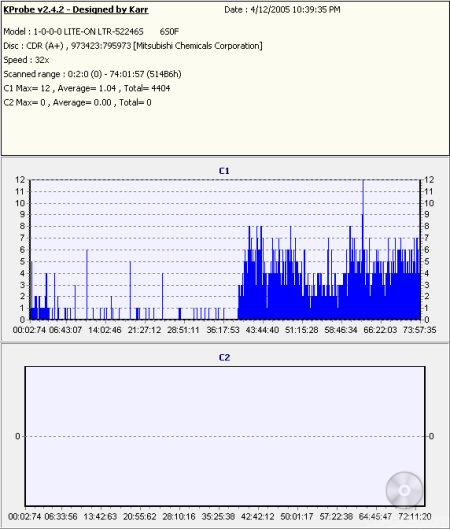 Verbatim 52x |
The dvd640i's writing quality was very good. By looking at the KProbe screenshots, you can see that the discs burned by the drive had a low number of C1 errors. More importantly, there were no C2 errors at all.
For the rewriting tests I created 400MB of files on the hard drive and wrote them in DAO mode using Nero. To test the packet writing speeds I copied and pasted the same files off the hard drive onto a CD-RW disc using DLA from Sonic. Verbatim's 24x Ultra Speed CD-RW media was used for these tests.

When rewriting at 24x, the DW1625 uses P-CAV, or Partial CAV, to reach this speed.By looking at the screenshot above, you can see that the drive starts rewriting at about 17.77x and accelerates, reaching its maximum speed at about the 14 minute mark.
| Software | HP dvd640i |
BenQ DW1625 |
Pioneer DVR-A09XL |
NEC ND-3520A |
| Nero | 2:22 | 2:23 | 2:58 | 2:42 |
| DLA Write | 2:26 | 2:29 | 2:38 | 2:24 |
| DLA Read | 1:18 | 1:14 | 4:05 | 1:34 |
HP's new DVD writer did very well in our rewriting tests. Thanks to its P-CAV writing method, the dvd640i took only 2:22 to write 400MB with Nero and 2:26 to do the same with DLA.
| HP dvd640i |
BenQ DW1625 |
Pioneer DVR-A09XL |
NEC ND-3520A |
|
| Quick Erase | 31 seconds | 32 seconds | 41 seconds | 42 seconds |
| Full Erase | 3:45 | 3:49 | 4:12 | 4:10 |
The dvd640i also erases at 24x. In our tests, it not only had the best quick erase time out of the four drives here, it was able to do a full erase in an impressive 3:45
Nero CD Speed v4.00 - DVD-ROM:
A little editorial note here. Like a CD-ROM, you will get different benchmark results depending on what kind of discs you are using. You are probably going to get varying results from a full data disc to a single layer movie disc. You're also going to get different results for single and dual layer discs.
The DVD Speed website recommends using a single layer DVD-ROM disc with a capacity of at least 4GB. If you use a dual layer disc you probably won't get the best results because most DVD-ROM drives slow down to read them. Some even slow down to read single layer DVD-Video discs. To make a long story short, I am using a 4.37GB single layer, single sided disc for this test.
| HP dvd640i |
BenQ DW1625 |
Pioneer DVR-A09XL |
NEC ND-3520A |
|
| Transfer Speed Average: Start: End: |
12.06x 6.57x 16.12x |
12.06x 6.58x 16.10x |
11.99x 6.64x 16.06x |
11.89x 6.52x 15.89x |
| Seek Times Random: 1/3: Full: |
99ms 109ms 171ms |
100ms 109ms 171ms |
110ms 129ms 209ms |
128ms 138ms 229ms |
| CPU Usage 1x: 2x: 4x: 8x: |
6% 12% 23% 46% |
6% 12% 23% 45% |
5% 9% 15% n/a |
8% 15% 28% 55% |
HP's new drive performed very well when reading single layer DVD-ROM's. In the transfer rate tests, the dvd640i started reading at 6.57x and reached a maximum transfer speed of about 16.12x. Like in our CD read tests, its seek times were also quite good.
Nero CD Speed v4.00 - DVD-R and DVD-RW:
First, we'll look at the drive's DVD-R and DVD-RW reading performance. For this I made copies of our DVD-ROM test disk using some general use 4x DVD-R and 2x DVD-RW media from Verbatim and then ran our usual DVD read tests with CD Speed. The results are below.
Verbatim DVD-R
| HP dvd640i |
BenQ DW1625 |
Pioneer DVR-A09XL |
NEC ND-3520A |
|
| Transfer Speed Average: Start: End: |
6.23x 3.43x 8.34x |
6.23x 3.43x 8.34x |
9.35x 5.19x 12.51x |
11.91x 6.56x 15.93x |
| Seek Times Random: 1/3: Full: |
104ms 113ms 171ms |
104ms 115ms 172ms |
114ms 136ms 217ms |
122ms 146ms 251ms |
| CPU Usage 1x: 2x: 4x: 8x: |
6% 12% 23% 45% |
6% 12% 23% 45% |
6% 26% n/a n/a |
9% 17% 31% 63% |
Verbatim DVD-RW
| HP dvd640i |
BenQ DW1625 |
Pioneer DVR-A09XL |
NEC ND-3520A |
|
| Transfer Speed Average: Start: End: |
6.25x 3.42x 8.35x |
6.24x 3.43x 8.33x |
6.25x 3.47x 8.36x |
5.97x 3.28x 7.98x |
| Seek Times Random: 1/3: Full: |
105ms 115ms 172ms |
103ms 116ms 172ms |
121ms 138ms 238ms |
108ms 138ms 229ms |
| CPU Usage 1x: 2x: 4x: 8x: |
6% 12% 23% 45% |
6% 12% 23% 45% |
6% 26% n/a n/a |
8% 14% 26% 81% |
HP's new drive wasn't nearly as fast when reading DVD-R and DVD-RW media. In both cases, the dvd640i reached a maximum transfer speed of about 8.3x.
Verbatim DVD-R DL
|
|
Transfer Speed | Seek Times | CPU Usage | ||||||
| Average | Start | End | Random | 1/3 | Full | 1x | 2x | 4x | |
|
HP dvd640i |
6.04x | 3.35x | 8.06x | 112ms | 117ms | 175ms | 6% | 12% | 91% |
While not officially supported, the dvd640i had no problems reading Verbatim's new dual layer DVD-R media. In our tests, the drive started reading at 3.35x and reached a maximum transfer speed of 8.06x.
Nero CD Speed v4.00 - DVD+R and DVD+RW:
Next we'll look at the drive's DVD+R and DVD+RW reading performance. For this I made a copy of our DVD-ROM test disk using some 4x DVD+R and 2.4x DVD+RW media from Verbatim. I then ran our usual DVD read tests with CD Speed. The results are below.
Verbatim DVD+R
| HP dvd640i |
BenQ DW1625 |
Pioneer DVR-A09XL |
NEC ND-3520A |
|
| Transfer Speed Average: Start: End: |
6.23x 3.42x 8.34x |
6.21x 3.44x 8.30x |
9.36x 5.18x 12.53x |
11.93x 6.55x 15.95x |
| Seek Times Random: 1/3: Full: |
103ms 117ms 172ms |
103ms 116ms 172ms |
116ms 140ms 221ms |
118ms 146ms 259ms |
| CPU Usage 1x: 2x: 4x: 8x: |
6% 12% 23% 45% |
6% 12% 23% 45% |
6% 27% n/a n/a |
9% 16% 31% 64% |
Verbatim DVD+RW
| HP dvd640i |
BenQ DW1625 |
Pioneer DVR-A09XL |
NEC ND-3520A |
|
| Transfer Speed Average: Start: End: |
6.24x 3.42x 8.34x |
6.24x 3.43x 8.34x |
6.25x 3.46x 8.35x |
5.97x 3.29x 7.98x |
| Seek Times Random: 1/3: Full: |
103ms 117ms 173ms |
102ms 118ms 172ms |
113ms 132ms 218ms |
111ms 141ms 235ms |
| CPU Usage 1x: 2x: 4x: 8x: |
6% 12% 23% 45% |
6% 12% 23% 45% |
7% 27% n/a n/a |
7% 13% 25% 81% |
The dvd640i's performance with DVD+R and DVD+RW media was very similar to what we saw with DVD-R and DVD-RW media. Here too the drive reached a maximum transfer speed of about 8.3x.
Verbatim DVD+R DL
| HP dvd640i |
BenQ DW1625 |
Pioneer DVR-A09XL |
NEC ND-3520A |
|
| Transfer Speed Average: Start: End: |
6.04x 3.35x 8.07x |
6.04x 3.35x 8.06x |
5.69x 3.17x 7.60x |
3.44x 1.91x 4.59x |
| Seek Times Random: 1/3: Full: |
106ms 118ms 172ms |
107ms 119ms 172ms |
120ms 139ms 234ms |
123ms 175ms 279ms |
| CPU Usage 1x: 2x: 4x: |
10% 19% 92% |
10% 20% 94% |
5% 10% n/a |
7% 91% n/a |
HP's new DVD writer had no problems reading Verbatim's double layer DVD+R media. The dvd640i started reading at 3.35x and reached a maximum transfer speed of 8.07x.
Nero CD Speed v4.00 - DVD-Video:
For these tests I am using the US version of Transformers: The Movie on DVD. The disc is over 4GB and single sided.
| HP dvd640i |
BenQ DW1625 |
Pioneer DVR-A09XL |
NEC ND-3520A |
|
| Transfer Speed Average: Start: End: |
11.94x 6.52x 15.96x |
11.94x 6.52x 15.96x |
11.87x 6.57x 15.95x |
3.72x 2.05x 4.98x |
| Seek Times Random: 1/3: Full: |
99ms 109ms 171ms |
99ms 109ms 171ms |
110ms 126ms 206ms |
111ms 128ms 206ms |
| CPU Usage 1x: 2x: 4x: 8x: |
6% 12% 23% 46% |
6% 13% 23% 46% |
5% 9% 15% n/a |
7% 13% 23% n/a |
The dvd640i didn't slow down very much when reading single layer DVD videos. It started out at about 6.52x and reached a maximum read speed of 15.96x. HP's new drive was also fairly quick when reading dual layer discs. By looking at the screenshot below, you can see that the drive's transfer speeds peaked at about 8x.
To see how well the dvd640i worked as a DVD player, I watched a few scenes from Transformers: The Movie and Star Wars: The Phantom Menace using WinDVD 4 and PowerDVD 5. The drive had no problems playing back these movies with either program and was fairly quiet.
DVD Write and ReWrite Tests - Nero Burning Rom 6.6.0.12 and DLA 4.90:
To test the DVD writing performance of HP's new drive I used Verbatim 16x DVD+R, 8x DVD-R, 4x DVD-RW and 4x DVD+RW media. To get the writing times, a 4.38GB image was burned to our test discs using Nero.
The dvd640i has a maximum DVD+R writing speed of 16x. To reach this speed, the drive uses CAV. Using Verbatim's 16x DVD+R media, it starts writing at 5.60x and accelerates, reaching its maximum speed at the end of the disc. When writing to DVD+R and DVD-R media at 8x, HP's new drive uses P-CAV. This time around, the drive starts writing at about 6.69x and accelerates, reaching its maximum speed at about the 0.4GB mark.
The dips in the graphs are due to the dvd640i's WOPC II (Walking Optimal Power Control) and BLER OPC (Block Error Rate Optimal Power Control) technologies and are not an indication of poor performance and/or writing quality. These technologies constantly monitor and evaluate the writing quality, adjusting the laser power in order to ensure the best writing quality possible over the entire disc.
| HP dvd640i |
BenQ DW1625 |
Pioneer DVR-A09XL |
NEC ND-3520A |
|
| DVD+R | 6:09 | 6:06 | 5:50 | 6:05 |
| DVD-R | 8:15 | 8:14 | 6:08 | 5:42 |
| DVD+RW | 14:27 | 14:35 | 14:26 | 9:45 |
| DVD-RW | 15:45 | 15:46 | 10:23 | 10:47 |
The dvd640i performed relatively well when writing to DVD+R discs at 16x.Unfortunately, due to its slower writing speeds, it had a hard time holding its own with other types of recordable media.
To check the media compatibility of the dvd640i, I ran a few tests using some of the media available in my area. The media types, along with the average time it took the drive to write our 4.38GB image, are listed below.
| Manufacturer ID | Max Write Speed |
Average Write Time |
|
| Taiyo Yuden 8x DVD+R | YUDEN000T02 | 8x | 9:02 |
| Fuji 16x DVD+R | PHILIPS C16 | 16x | 6:00 |
| Memorex 16x DVD+R | CMC MAG M01 | 16x | 6:02 |
| Optodisc 16x DVD+R | OPTODISCR16 | 16x | 8:52 |
| RiDATA 16x DVD+R | RITEKR04 | 16x | 8:57 |
| Verbatim 16x DVD+R | MCC-004 | 16x | 6:09 |
| Maxell 8x DVD-R | MXL RG03 | 8x | 8:16 |
| Memorex 8x DVD-R | CMC MAG.AE1 | 8x | 8:19 |
| Optodisc 8x DVD-R | OPTODISCR008 | 8x | 8:20 |
| RiDATA 8x DVD-R | RITEKG05 | 8x | 8:17 |
| Taiyo Yuden 8x DVD-R | TYG02 | 8x | 8:21 |
| Verbatim 8x DVD-R | MCC 02RG20 | 8x | 8:15 |
So what about writing quality? Testing a drive's DVD writing quality isn't easy. Until now, there were very few options, unless you wanted to shell out thousands of dollars for a certified test machine. Thanks to KProbe, we can test a disc's PI (Parity Inner) and PIF (Parity Inner Fail) rates.For these tests I used a Lite-On SOHW-1633S (firmware BS0S) and read the discs at 4x with the PI and PIF ECC sums set to 8 and 1 respectively. For comparison, I also tested the discs on a BenQ DW1620. When combined with Nero CD Speed, the DW1620 is able to report PI Errors, PI Failures, Parity Outer Failures and even jitter levels. For this test, the discs are read at 8x with both the PI and PIF ECC sums set to 8.
So what are "good" results supposed to look like? With KProbe, the PI errors should not exceed 280 and the number of PIF errors should stay below 4. When testing with CD Speed, the number of PI errors should stay below 280 as well. However, because it scans with an ECC sum of 8, a higher number of PIF errors is acceptable, as long as they do not exceed 32. Since POF errors are uncorrectable, we really don't want to see any of them at all.
I also put these discs through a "stress test" by reading them back with a Lite-On XJ-HD166S. By default, this DVD-ROM drive reads recordable media at only 8x. However, thanks to a firmware patched by The Dangerous Brothers, I was able to boost the drive's read speed to 12x. By reading these discs back at this speed, we can see if there are any readability issues caused by the number of errors or high levels of jitter.
|
|
|
||||||||||||||||||||||||||||||||||||||||||||||||||||||||||||||||||||||||
|
|
|
||||||||||||||||||||||||||||||||||||||||||||||||||||||||||||||||||||||||
With the original ES04 firmware, I was less than impressed with the dvd640i's writing quality. The PI/PIF rates were higher than we'd like to see, even with Verbatim's 16x DVD+R media. While better with the JS04 firmware, there's still room for improvement, especially with the Optodisc and RiDATA media. As it is, RiDATA discs failed to complete CD Speed's write quality test, returning an error about half of the way through.
|
|
|
||||||||||||||||||||||||||||||||||||||||||||||||||||||||||||||||||||||||
|
|
|
||||||||||||||||||||||||||||||||||||||||||||||||||||||||||||||||||||||||
Lastly, here are some results from our DVD-R test media. As you can see, the writing quality was pretty good with most of the discs we tested. Aside from a few small PI/PIF spikes, the results stayed within acceptable limits.
| HP dvd640i |
BenQ DW1625 |
Pioneer DVR-A09XL |
NEC ND-3520A |
|
| DVD+RW Quick | 14 seconds | 17 seconds | 27 seconds | 39 seconds |
| DVD+RW Full | 14:35 | 14:51 | 14:23 | 7:49 |
| DVD-RW Quick | 45 seconds | 51 seconds | 53 seconds | 55 seconds |
| DVD-RW Full | 15:34 | 15:51 | 10:21 | 14:43 |
To test the HP's packet writing performance I used DLA 4.90. Verbatim 4x DVD+RW and 4x DVD-RW media were used once again.
| HP dvd640i |
BenQ DW1625 |
Pioneer DVR-A09XL |
NEC ND-3520A |
|
| DVD+RW Write | 12:50 | 12:50 | 13:49 | 8:10 |
| DVD+RW Read | 11:51 | 8:58 | 14:47 | 9:20 |
| DVD-RW Write | 13:13 | 13:20 | 9:39 | 12:14 |
| DVD-RW Read | 9:06 | 9:02 | 11:40 | 9:46 |
The dvd640i didn't do as well as some of the other drives in our packet writing tests. It's 4x writing speed not only put it at a disadvantage, it took longer than expected to read back our test data from DVD+RW media.
DVD+R DL Write Tests - Nero Burning Rom 6.6.0.12:
To test the double layer DVD writing performance of the dvd640i, I used DVD+R DL media from both Memorex and Verbatim. I created about 8GB of random files and directories on my hard drive and then burned them to our test discs with Nero.
According to HP, the dvd640i writes to DVD+R DL media at 2.4x. Using CD Speed we can see that aside from the small dips caused by the drive's WOPC II and BLER OPC technologies, it writes at this speed from start to finish.
| DVD+R DL Write | HP dvd640i |
BenQ DW1625 |
Pioneer DVR-A09XL |
NEC ND-3520A |
| 2.4x | 45:15 | 45:12 | 44:17 | 42:53 |
| 4x | n/a | n/a | 27:04 | 26:17 |
| 6x | n/a | n/a | 19:04 | n/a |
The dvd640i's 2.4x writing speed put it at a huge disadvantage in this test. As you can see, it was considerably slower than the drives from Pioneer and NEC, taking more than 45 minutes to write 8001MB of data. So what about writing quality? Take a look below.
|
|
||||||||||||||||||||||||||||||||||||||||||||||||
Like with most drives, the writing quality was quite good with Verbatim's DVD+R DL media. Aside from the small spike at the layer change, the PI/PIF rates were very low from start to finish. The results with Memorex's DVD+R DL media were better than I expected. While higher than what we saw with the Verbatim discs, the PI/PIF remained for the most part within acceptable limits.
Performance Revisited:
While not one of the faster DVD writers we've tested, the dvd640i performed as expected throughout most of our tests. When it came to writing DVD's, HP's new drive turned in some pretty good times with DVD+R media. However, it's 8x DVD-R and 2.4x DVD+R DL writing speeds did put it at a disadvantage. Nevertheless, the dvd640i was fairly quick when reading DVD's. In our tests, it was able to read single layer data and video DVD's at speeds as high as 16x and most recordable media at 8x.
HP's new DVD writer also did pretty well in our CD read tests. It was able to read all types of media at its rated speeds and had some fairly good seek times. Writing CD's wasn't a problem for the dvd640i either. With its 40x CD-R writing speed, it wasn't as fast as some of the other drives we've tested. However, its writing quality was very good. With all things considered, the HP dvd640i gets an 8 out of 10 for the performance section of this review.
With the dvd640i, HP has introduced one of the first LightScribe capable DVD writers. This innovative technology lets users burn graphics and text onto the tops of specially coated discs. While this will appeal to some, first generation drives like the dvd640i aren't for everyone. Designed primarily for its LightScribe capabilities, HP has had to make some sacrifices in the way of performance, keeping the dvd640i from being one of the faster DVD writers currently available.
Like the BenQ drive its based on, the dvd640i can write to DVD+R media at 16x. At this speed, the drive took a little more than 6 minutes to turn out an entire 4.7GB DVD. Unfortunately, the dvd640i wasn't nearly as fast with other types of recordable media. While the drive performed as expected, its 8x DVD-R and 2.4x DVD+R DL writing speeds put it at a disadvantage in some of our tests.
When it came to media compatibility, the dvd640i gave us some mixed results. The drive wrote tomost of our test media at its rated speed, but like its BenQ counterpart, it would not write to any 8x DVD+R media at 16x. While this is becoming less of an issue as more 16x media becomes available, it's still a nice feature to have. The dvd640i's writing quality was pretty good for the most part. However, even with the latest firmware there is still room for improvement, especially with the 16x DVD+R discs from Optodisc and RiDATA.
HP's new DVD writer performed pretty well in our DVD read tests. The dvd640i read both single layer DVD-ROM's and DVD-Videos at speeds as high as 16x and had some very good seek times. Reading recordable media wasn't a problem for the drive either. In our tests, the dvd640i read DVD±R, DVD±RW and DVD±R DL media at a respectable 8x.
Reading and writing CD's wasn't a problem for the dvd640i either. In our tests, the drive was able to read all types of media at 40x and had some good seek times. This level of performance carried over to our DAE tests, where HP's new drive ripped audio CD's at 40x. As a writer, the dvd640i performed as expected. The drive's 40x CD-R writing speed did put it at a slight disadvantage in some of our tests. However, its writing quality was very good.
The dvd640i also has its share of features. To prevent buffer underruns, it has a 2048KB buffer that is backed up by some sort of buffer underrun technology. The drive also has a good number of writing and rewriting speeds to choose from and has the ability to set the book type of DVD+R/RW and DVD+R DL media. Most notable though, is the dvd640i's LightScribe Direct Disc Labeling system. While a nice alternative to markers and stick on labels, it does have its down sides, including long printing times and the lack of color.
HP's new DVD writer is shipping now and can be purchased through some of the vendors listed on Pricegrabber.Prices vary depending on the seller, but the retail version of the dvd640i can be picked up for less than $80.
| HP dvd640i 16x DVD±RW |
|
| Features: Installation: Performance: |
8 9 8 |
| Overall: | 8 |
Highs:
- Supports LightScribe technology
- Writes to DVD+R media at 16x
- Writes to DVD-RW and DVD+RW media at 4x
- Reads single layer DVD-ROM's at 16x
- Reads DVD+R/RW, DVD-R/RW and DVD+R DL mediaat 8x
- Good transfer speeds with all types of CD media
- Features 40x CD-R and 24x CD-RW writing speeds
- Good DAE speeds
- Low seek times
- Good CD writing quality
- Supports Seamless Link buffer underrun protection
- Includes software from Sonic, ArcSoft, CyberLink and SureThing
- Supports 99 minute media
- Supports bitsetting for DVD+R/RW and DVD+R DL media
- Writes to DVD-R media at only 8x
- Writes to DVD+R DL media at only 2.4x
- Cannot write to 8x DVD+R media at 16x
- Questionable writing quality with some 16x DVD+R media
- Has a 2048KB buffer
- More expensive than normal 16x DVD writers


